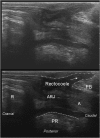Total pelvic floor ultrasound for pelvic floor defaecatory dysfunction: a pictorial review
- PMID: 26388109
- PMCID: PMC4743465
- DOI: 10.1259/bjr.20150494
Total pelvic floor ultrasound for pelvic floor defaecatory dysfunction: a pictorial review
Abstract
Total pelvic floor ultrasound is used for the dynamic assessment of pelvic floor dysfunction and allows multicompartmental anatomical and functional assessment. Pelvic floor dysfunction includes defaecatory, urinary and sexual dysfunction, pelvic organ prolapse and pain. It is common, increasingly recognized and associated with increasing age and multiparity. Other options for assessment include defaecation proctography and defaecation MRI. Total pelvic floor ultrasound is a cheap, safe, imaging tool, which may be performed as a first-line investigation in outpatients. It allows dynamic assessment of the entire pelvic floor, essential for treatment planning for females who often have multiple diagnoses where treatment should address all aspects of dysfunction to yield optimal results. Transvaginal scanning using a rotating single crystal probe provides sagittal views of bladder neck support anteriorly. Posterior transvaginal ultrasound may reveal rectocoele, enterocoele or intussusception whilst bearing down. The vaginal probe is also used to acquire a 360° cross-sectional image to allow anatomical visualization of the pelvic floor and provides information regarding levator plate integrity and pelvic organ alignment. Dynamic transperineal ultrasound using a conventional curved array probe provides a global view of the anterior, middle and posterior compartments and may show cystocoele, enterocoele, sigmoidocoele or rectocoele. This pictorial review provides an atlas of normal and pathological images required for global pelvic floor assessment in females presenting with defaecatory dysfunction. Total pelvic floor ultrasound may be used with complementary endoanal ultrasound to assess the sphincter complex, but this is beyond the scope of this review.
Figures

















References
-
- Beer Gabel M, Assoulin Y, Amitai M, Bardan E. A comparison of dynamic transperineal ultrasound (DTP-US) with dynamic evacuation proctography (DEP) in the diagnosis of cul de sac hernia (enterocoele) in patients with evacuatory dysfunction. Int J Colorectal Dis 2008; 23: 513–19. - PubMed
Publication types
MeSH terms
LinkOut - more resources
Full Text Sources
Other Literature Sources
Medical

